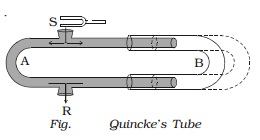Chapter: 11th 12th std standard Class Physics sciense Higher secondary school College Notes
Experimental demonstration of interference of sound

Experimental demonstration of
interference of sound
The
phenomenon of interference between two longitudinal waves in air can be
demonstrated by Quincke?s tube shown in Fig..
Quincke?s
tube consists of U shaped glass tubes A and B. The tube SAR has two openings at
S and R. The other tube B can slide over the tube A. A sound wave from S
travels along both the paths SAR and SBR in opposite directions and meet at R.
If the path difference between the two waves
(i.e) SAR ~ SBR is an integral multiple of wavelength, intensity of sound will
be maximum due to constructive interference.
i.e
SAR ~ SBR = mλ The corresponding phase difference φ between the two waves is
even multiples of π. (i.e) φ = m 2π where m = 0, 1, 2, 3 ....
If the tube B is
gradually slided over A, a stage is reached when the intensity of sound is zero
at R due to destructive interference. Then no sound will be heard at R.

If the path difference
between the waves is odd multiples of λ/2 , intensity of sound will be minimum.
i.e. SAR ~
SBR = (2m + 1) λ/2
The corresponding
phase difference φ between the two waves
is odd multiples of π. (i.e) φ = (2m
+ 1)π where m = 0, 1, 2, 3 ....
Related Topics